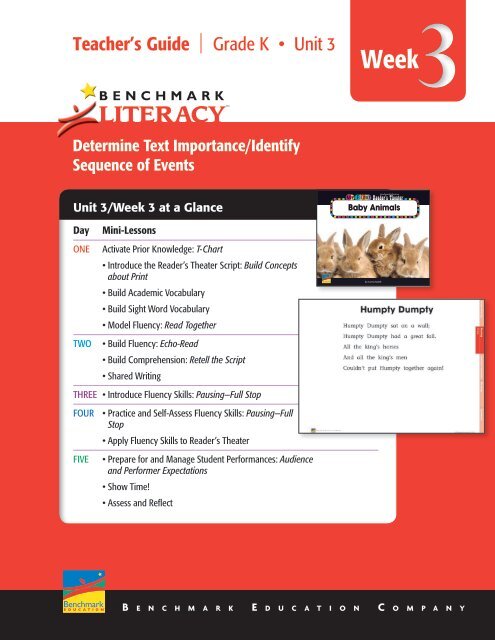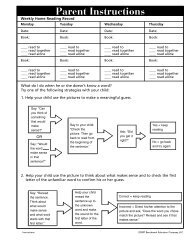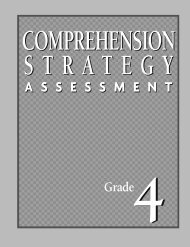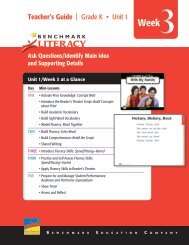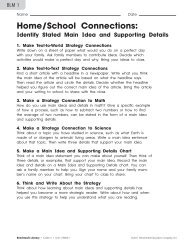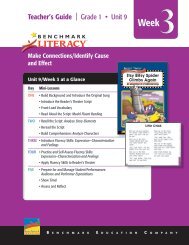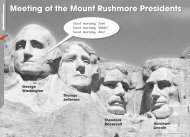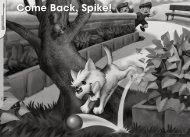Literacy - Benchmark Resources - Benchmark Education Company
Literacy - Benchmark Resources - Benchmark Education Company
Literacy - Benchmark Resources - Benchmark Education Company
Create successful ePaper yourself
Turn your PDF publications into a flip-book with our unique Google optimized e-Paper software.
Day TwoCut each sentence strip into individual word cards. Ask students to put thesentences together to match the sentences in the book.Ask: Which baby animals did we see? What did the baby animals do thatshowed they were good?Shared WritingDisplay page 4 of the Baby Animals lap book on an easel.Explain to students that they will write their own sentences using the samesentence patterns that are in the book.Ask a volunteer to read the first sentence on page 4: I see 2 puppies. Ask otherstudents to reread the sentence together.Ask: What other baby animals can we write about? How many could we see?If necessary, reread the baby animals students brainstormed on their “BabyAnimals” chart on Day 1.Say: Let’s say our sentence together: I seewill write? That’s right. We’ll write the word I.. What is the first word weWrite the word on chart paper. Repeat this process to write the completesentence with students. Reread the sentence.If time allows, work with students to write the sentences:Come here, .What good !Make Content Comprehensiblefor ELLsBeginningPoint to each picture word on page 2.Ask: What do you see? Model the answer.Say: I see bunnies. Repeat for each picture.Then ask the questions again, but havestudents answer on their own.IntermediatePair students and ask them to use gesturesas they echo-read the script.All LevelsPair ELLs with fluent English speakersduring discussions and activities.Echo-Reading Checklist• Point out the rise and fall of the voiceduring reading.• Read smoothly and in phrased units.• Pause or stop at the end of a sentencewith a period.• Read the text as if you were talking tosomeone.• Demonstrate how you speak louder andwith more emphasis when the sentenceends with an exclamation mark.Choral-read your sentences together. Then invite individual students to taketurns pointing to each word as they read it aloud to the class.Connect and transfer. Say: Remember, good readers read smoothly and withexpression. They can do this because they’ve learned to recognize familiarwords automatically and can read them without stopping. Tonight, when youread with your family members, practice being good readers.©2011 <strong>Benchmark</strong> <strong>Education</strong> <strong>Company</strong>, LLC <strong>Benchmark</strong> <strong>Literacy</strong> • Grade K • Unit 3/Week 3 7
Day TwoOral Language ExtensionDuring independent workstation time,display the pocket chart with word cardsforming the sentence patterns from thebook and post pictures of other babyanimals across the top of the chart. Invitepairs of students to reread the sentencestogether and to form new oral sentencesabout the other baby animals, using thesame sentence patterns. Ask students toshare their sentences with you during theirindividual student conferences.Home/School ConnectionAsk students to read their take-home scriptagain at home with a family member andto practice reading smoothly and withexpression.Small-Group Reading Instruction (60 m i n u t e s)Based on students’ instructional reading levels and comprehension needs,select titles that provide opportunities for students to continue to practiceidentifying sequence of events (see the list provided on the Small-GroupReading Instructional Planner), or select titles that enable students to reviewpreviously taught comprehension strategies.Use the instruction provided in the Teacher’s Guide to introduce the texts.Individual Student Conferences (10 m i n u t e s)Confer with individual students on their text selections and application ofstrategies. Use the Reading Conference Note-Taking Form to help guide yourconference.Phonics Workshop (20 m i n u t e s)Use the Day 2 instruction provided in StartUp Phonics Skill Bag 4.8<strong>Benchmark</strong> <strong>Literacy</strong> • Grade K • Unit 3/Week 3©2011 <strong>Benchmark</strong> <strong>Education</strong> <strong>Company</strong>, LLC
Day ThreeRead-Aloud (10 m i n u t e s)Select a favorite nonfiction read-aloud from your classroom or school librarywith which to model the metacognitive strategy “Determine Text Importance.”Use the sample read-aloud lessons and suggested titles in the <strong>Benchmark</strong><strong>Literacy</strong> Overview.Mini-Lessons (20 m i n u t e s)Introduce Fluency Skills: Pausing—Full StopExplain: We have learned that we pause, or rest, between some words.Pausing helps us divide our sentences into meaningful parts, which helpslisteners understand what we are saying, too. Punctuation helps us figure outwhen to pause. The punctuation at the end of a sentence signals a longerpause than the punctuation inside the sentence. At the end of a sentence, wecome to a full stop and take a breath before the next sentence.Display the fluency poster “Humpty Dumpty” and read aloud the title.(Note: The poster is also available as BLM 1.)Say: This is a rhyme. It is about a story character who is an egg and falls off awall. The author uses a period and an exclamation mark to show us when tocome to a full stop. Coming to a full stop helps the rhyme sound right and makesense. Listen as I read the rhyme. Try to notice where I come to a full stop.Point to each word as you read the rhyme aloud, coming to a full stop at theend of the second and last lines. For example:Fluency PosterLesson ObjectivesStudents will:• Practice reading a rhyme withpausing to a full stop.• Compose a class Fluency anchorchart.• Build oral language and vocabularythrough whole-group and partnerdiscussion.Related <strong>Resources</strong>• Audio CD• Humpty Dumpty (BLM 1)Read with a short pause after the semicolon:Humpty Dumpty sat on a wall;Read with a full stop after the period:Humpty Dumpty had a great fall.Read all the way through to the end, and then stop:All the king’s horsesAnd all the king’s menCouldn’t put Humpty together again!Next say: Now I will read the rhyme again. This time, I will not stop or pause at all.Read the entire rhyme in a monotone and constant speed, with no pauses.Ask: Which reading makes the rhyme sound better and easier to understand?Why?©2011 <strong>Benchmark</strong> <strong>Education</strong> <strong>Company</strong>, LLC <strong>Benchmark</strong> <strong>Literacy</strong> • Grade K • Unit 3/Week 3 9
Day ThreeMake Content Comprehensiblefor ELLsBeginning and IntermediateRead the rhyme aloud, pointing to eachword as you say it. Invite students tohold up their hands to act out a “stop”command to let you know when to stop.All LevelsBefore reading the poster to modelfluency, read and support comprehensionof unfamiliar words and concepts bypointing to pictures to illustrate thefollowing words: Humpty Dumpty, wall,king, horses, men.Comprehension Quick-CheckThe goal of fluency practice is toincrease comprehension. Use thefollowing questions to check students’comprehension of the rhyme:• What was this rhyme mostly about?• Think about a broken egg. Why wouldthe king’s horses and men have a hardtime putting Humpty Dumpty togetheragain?• Do you think this is a real story ormake-believe? Why?Home/School ConnectionInvite students to take home HumptyDumpty (BLM 1) and choral-read it with afamily member to build fluency.Shared Writing. Invite students to help you create a class anchor chart toremind them how good readers use pausing. (See the example provided.)When you are finished, ask students to echo-read the entire chart. Then postthe chart in the classroom for future reference.Connect and transfer. Say: Today during small-group reading, look for endpunctuation marks, such as periods or exclamation marks, that signal fullstops. Read as smoothly and naturally as you can before coming to a stop.Pausing• We do not run all our words together.• We pause, or rest, between somewords.• Pausing divides sentences intomeaningful parts.• Pausing makes our reading easier tounderstand.• Punctuation helps us figure out whento pause.• Punctuation helps us figure out howlong to pause.Sample Anchor ChartSmall-Group Reading Instruction (60 m i n u t e s)Use the small-group reading time to read Baby Animals.Use the Day 3 instruction provided in the My First Reader’s Theater Teacher’sGuide to assign roles and guide students’ reading of the script.Individual Student Conferences (10 m i n u t e s)Confer with individual students to discuss their script roles and how they planto read their parts. Use the Reading Conference Note-Taking Form to helpguide your conference.Phonics Workshop (20 m i n u t e s)Use the Day 3 instruction provided in StartUp Phonics Skill Bag 4.10<strong>Benchmark</strong> <strong>Literacy</strong> • Grade K • Unit 3/Week 3©2011 <strong>Benchmark</strong> <strong>Education</strong> <strong>Company</strong>, LLC
Day FourRead-Aloud (10 m i n u t e s)Select a favorite nonfiction read-aloud from your classroom or school librarywith which to model the metacognitive strategy “Determine Text Importance.”Use the sample read-aloud lessons and suggested titles in the <strong>Benchmark</strong><strong>Literacy</strong> Overview.Mini-Lessons (20 m i n u t e s)Practice and Self-Assess Fluency Skills:Pausing—Full StopDistribute copies of Humpty Dumpty (BLM 1).Ask students to choral-read the rhyme with you one or more times.Next, allow students to choral-read the rhyme without your assistance.Distribute the Fluency Self-Assessment Master Checklist (BLM 2) and reviewthe assessment criteria for pausing and integration. Ask students to give athumbs-up or thumbs-down on each question based on the group’s choralreading.Discuss their responses.Partner reading. Pair students and ask them to read Humpty Dumptytogether one or more times, alternating lines.Monitor students’ partner-reading practice and provide responsive feedbackusing appropriate prompts from the list on page 12.Ask students to rate themselves on specific fluency skills covered in this lessonusing their Fluency Self-Assessment Master Checklist (BLM 2).Fluency PosterLesson ObjectivesStudents will:• Utilize punctuation to signal fullstops while reading.• Demonstrate understanding of thetext through purposeful pausing.• Use effective pausing to make theirreading sound like talking.Related <strong>Resources</strong>• Audio CD• Humpty Dumpty (BLM 1)• Fluency Self-Assessment MasterChecklist (BLM 2)• Baby Animals (BLM 3)Connect and transfer. Ask students to reflect on their fluency practice, usingthe following prompts:• When you read, how do you know when to come to a full stop?• Where does the author place the punctuation mark that signals afull stop?• How will you use what you have learned as you practice reading BabyAnimals?©2011 <strong>Benchmark</strong> <strong>Education</strong> <strong>Company</strong>, LLC <strong>Benchmark</strong> <strong>Literacy</strong> • Grade K • Unit 3/Week 3 11
Day FourMake Content Comprehensiblefor ELLsBeginningAllow ELLs to participate through activelistening while other students demonstratefull stop pausing. Invite them to raise theirhands when they hear a full stop.Intermediate and AdvancedAllow ELLs to echo-read parts of the scriptwith you as they demonstrate their abilityto come to a full stop and then continuereading smoothly.BLM 2Name<strong>Benchmark</strong> <strong>Literacy</strong> • Grade K • Unit 3/Week 3DateFluency Self-Assessment Master ChecklistSpeed/PacingDid my speed and pacing match the kind of text I was reading?Did my speed and pacing match what the character was saying?Did I read with a natural talking voice?Did I slow my reading down when appropriate?Did I pay attention to punctuation?PausingDid I pause to keep from running all my words together?Did I pause in the correct locations?Did I pause for the appropriate length of time?Did I pause to help my reading make sense?Did I use punctuation to help me figure out when to pause?Inflection/IntonationDid I make my voice rise at a question mark?Did I make my voice fall at a period?Did I think about what the author was saying so I would know whento read louder or softer?Did I think about what the author was saying so I would know whento stress or emphasize words?PhrasingDid I notice the phrases?Did I read all the words in each phrase together?Did I think about what the words in the phrase mean when they aretogether?ExpressionDid I look for clues so I could anticipate the mood of the passage?Did I use my tone of voice, facial expressions, and body language toexpress what the author or characters were thinking or feeling?Did I change my reading when something new was about to happen?IntegrationDid I read the words right? (accuracy)Did I read the words at the right speed? (rate)Did I read with expression? (prosody)Did my reading sound like talking?Did I understand what I read?Fluency Self-Assessment MasterChecklist (BLM 2)sS©2010 <strong>Benchmark</strong> <strong>Education</strong> <strong>Company</strong>, LLCResponsive Prompts for Speed and PacingAs students work together, observe those who demonstrate understandingand those who struggle. Use appropriate responsive prompting to provideadditional support or to validate students who demonstrate mastery.Goal Oriented• Listen to me read this. Can you hear me take a little breath at the semicolon?• The period (exclamation point) means your voice makes a full stop.• When I make a short pause, I don’t stop completely and break the flow ofmy reading.• When I finish a sentence, I make a full stop before continuing with my reading.• Notice what I do when I see a semicolon. My reading pauses briefly andthen continues to help make ideas clear as I read.• Notice what I do when I see a(n) period (exclamation point). My readingpauses with a full stop to show that I’ve read a complete sentence or idea.Directive and Corrective Feedback• Make a full stop at the period (exclamation point).• Take a little breath when you see a semicolon.• Read the punctuation.• Read it like this with a short pause between the words.• Read it like this with a full stop after the word.• Make your pause longer.• Maker your pause shorter.Self-Monitoring and Reflection• How did you know to make a short pause here?• How did you know to make a full stop here?• Did you have any trouble knowing where to make a short pause or fullstop as you read?• Was your pausing too short, too long, or just right?• Where did you make short pauses as you read?• Where did you make full stops as you read?Validating and Confirming• Good—you took a little breath.• Good—you made a full stop.• I like the way you made a short pause/full stop here.• I like the way you used the punctuation mark to help you make ashort pause/full stop here.• Good—you used punctuation marks to help you know when to pause andfor how long!12<strong>Benchmark</strong> <strong>Literacy</strong> • Grade K • Unit 3/Week 3©2011 <strong>Benchmark</strong> <strong>Education</strong> <strong>Company</strong>, LLC
Day FourApply Fluency Skills to Reader’s TheaterDisplay the Baby Animals lap book and turn to page 4.Say: Let’s take what we have learned about making a full stop and use it aswe reread a few pages of the script. Listen as I read. After I finish, I want youto tell me when I made a full stop and how that helped the script make sensefor you as listeners.I see 2 .puppiesCome here, .puppiesWhat good !puppies4Baby Animals, pages 4–55Read pages 4–7. Make a full stop at the end of each sentence. Use thesuggestions below or interpret the text in your own way:• Red Group: moderate speed, full stop• Blue Group: in a calling tone, short pause after comma, then full stop• Purple Group: excited voice, full stopAsk students to comment on your reading and how it affected them aslisteners. Then invite volunteers to read aloud and use expressiveness and fullstops following your example.Small-Group Reading Instruction (60 m i n u t e s)Practice reading Baby Animals.Use the Day 4 instruction provided in the My First Reader’s Theater Teacher’sGuide to help students rehearse for their performance.Individual Student Conferences (10 m i n u t e s)Confer with individual students on their fluency development. Use the ReadingConference Note-Taking Form to help guide your conference.6I see 3 .lambsCome here, .lambsWhat good !lambsBaby Animals, pages 6–7Oral Language ExtensionHave pairs of students practice fluencyduring independent workstation time byreading aloud Humpty Dumpty (BLM 1).Students will:• choral-read the passage together• take turns reading to each otherHome/School ConnectionHave students take home the BabyAnimals activity page (BLM 3) anddraw their own pictures to completeeach sentence. Ask them to ask a familymember for help with writing the numberof animals they see. Have them read theirsentences to a family member.7Phonics Workshop (20 m i n u t e s)Use the Day 4 instruction provided in StartUp Phonics Skill Bag 4.©2011 <strong>Benchmark</strong> <strong>Education</strong> <strong>Company</strong>, LLC <strong>Benchmark</strong> <strong>Literacy</strong> • Grade K • Unit 3/Week 3 13
Day FiveM y F i r stBaby AnimalsRead-Aloud (10 m i n u t e s)Revisit the week’s read-alouds to make text-to-text connections and provideopportunities for reader response. Use the suggested activities in the<strong>Benchmark</strong> <strong>Literacy</strong> Overview, or implement ideas of your own.by Carrie SmithReader’s Theater Lap BookLesson ObjectivesStudents will:• Demonstrate their level of fluencydevelopment through an oralreading interpretation of the script.• Demonstrate active listening skills.• Reflect on and assess their ownfluency development.Related <strong>Resources</strong>• Audio CD• Reader’s Theater Self-Assessment(BLM 4)Mini-Lessons (20 m i n u t e s)Prepare for and Manage Student Performances:Audience and Performer ExpectationsPrepare students for their reader’s theater performances by sharing yourexpectations of audience members and performers.Audience expectations. Say: While you are listening to the other groupsperform, I expect you to do the following:• Give your classmates your full attention.• Do not speak to your neighbors or make any noise.• Enjoy their performance and show your appreciation by clapping whenthey are finished.• Be prepared to give your feedback on the script, and always rememberto make your feedback constructive, or helpful.Performer expectations. Say: While you and your group are performing thescript, remember to do these things:• Read in a loud, clear voice and act out your role.• Use expression and fluency to help everyone listening to understandyour character.• Remember to come to a full stop at end punctuation marks.• When it is not your turn to read, follow along in the script so you knowwhen to come in.• If one of your group members gets lost or forgets to come in, prompthim or her quietly.• Accept both suggestions and praise from your audience.Show Time!Invite students to perform the script for an audience such as members of theclass, students from other classes, school staff members, or parents.Continue your performances during small-group reading time, giving eachgroup the opportunity to perform.14<strong>Benchmark</strong> <strong>Literacy</strong> • Grade K • Unit 3/Week 3©2011 <strong>Benchmark</strong> <strong>Education</strong> <strong>Company</strong>, LLC
Day FiveAssess and ReflectAfter all groups have completed their performance, use the followingself-assessment activity to help students reflect on their performance, identifyhow they have improved as readers and performers, and determine whatthey will focus on as they participate in future reader’s theater experiencesthroughout the year.Draw a three-column reflection chart on chart paper. Include a column forReflection Questions and columns to answer Yes or No in response. Use thefollowing questions to guide the group’s assessment of their performance, oruse the Reader’s Theater Self-Assessment (BLM 4). Place a check mark in theappropriate column, noting their responses.• Did we make our reading sound smooth like talking?• Did we make our characters sound and feel like real people withfeelings?• Did we act out our parts with our voices and body language?• Were our parts at “just right” reading levels?• Did we practice our reading many times before performing?• Did we come to a full stop at end punctuation marks to supportlisteners’ understanding of the script?Connect and transfer. Discuss ways to improve future performances basedon the self-assessment and reflections.Small-Group Reading Instruction (60 m i n u t e s)Use the small-group reading time to continue students’ performances ofBaby Animals.After all groups have performed, use the Assess and Reflect activity above.BLM 4Name<strong>Benchmark</strong> <strong>Literacy</strong> • Grade K • Unit 3/Week 3Reader’s Theater Self-Assessment (BLM 4)Support Participation of ELLsBeginningAllow beginning ELLs to participateas active listeners by using gesturesto demonstrate the Blue group linesthroughout the performance.Intermediate and AdvancedGroup ELLs with more fluent readers tochoral-read their part in the script.Assessment TipDuring student performances, recordanecdotal notes that focus on howstudents are developing fluency skills andhow they are meeting performer andaudience member expectations.DateReader’s Theater Self-AssessmentDirections: Answer each question by coloring the face that bestshows how you feel about your reading.1. Did my reading sound like talking?s S ß2. Did I use my voice to show the character’s feelings?s S ß3. Did I say the lines like the character would say them?s S ß4. Did I use the punctuation marks to help me know how to saythe words?s S ß5. Did I read with a good speed?s S ß6. Did I fix my mistakes when I read?s S ß7. Did I act like the character?s S ß8. Did I listen carefully to the other readers?s S ß©2010 <strong>Benchmark</strong> <strong>Education</strong> <strong>Company</strong>, LLCIndividual Student Conferences (10 m i n u t e s)Have students use their self-reflection to show how they would read differentlynext time. Discuss how students plan to apply what they learned to futureperformances and independent reading.Phonics Workshop (20 m i n u t e s)Use the Day 5 instruction provided in StartUp Phonics Skill Bag 4.©2011 <strong>Benchmark</strong> <strong>Education</strong> <strong>Company</strong>, LLC <strong>Benchmark</strong> <strong>Literacy</strong> • Grade K • Unit 3/Week 3 15


